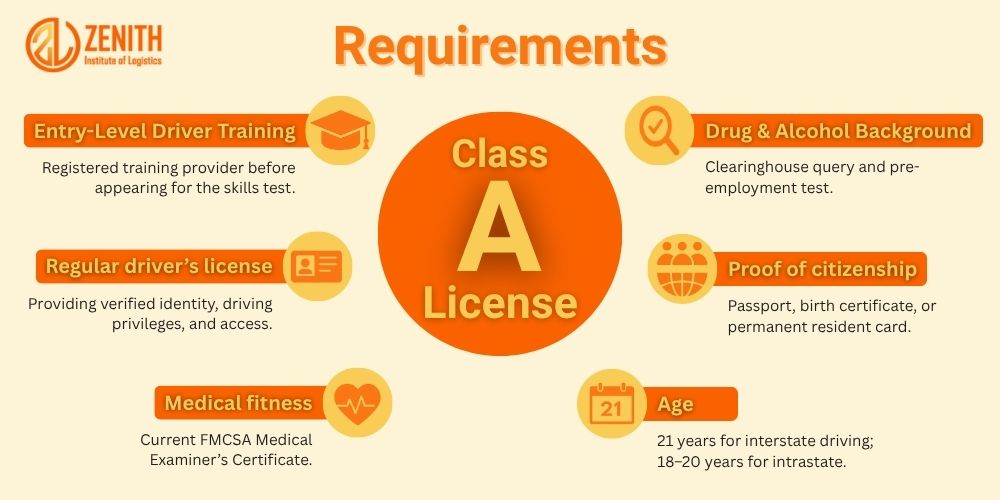How to Get Your Class A CDL in 5 Easy Steps

A Class A Commercial Driver’s License (CDL) is the gateway to commanding the road in vehicles like semi-trailers, flatbeds, and livestock haulers. With this license, you’re not just certified—you’re career-ready for high-demand jobs that keep the country’s freight moving.
It gives you a good push to earn a higher paycheck. To help you in this venture, we have put together a five-step plan that reflects current federal rules from the FMCSA and the ELDT mandate. Looks complicated? Let’s make all this easier for you step by step.
What Is a Class A License?
You must be licensed with a Class A CDL to operate combination vehicles when their GCWR exceeds 26,001 pounds, according to the FMCSA. The towed vehicle must have a minimum weight of 10,000 pounds. This is necessary to qualify under Class A licence requirements. Various trailers, double trailers, tankers, and flatbeds are included as types in the fleet.
Because of the heavier weights involved, the agency requires additional knowledge tests (general knowledge, combination vehicles, air brakes) and a three-part skills test. Drivers must also meet higher medical and background standards than those who hold only a regular automobile license.
What Does a Class A Driver Do?
Holders of a Class A CDL move freight locally, regionally, or across state lines. Typical assignments include:
- Long-haul tractor-trailer driving for national carriers
- Regional food or retail delivery with dry-van or refrigerated trailers
- Specialized hauling such as heavy equipment or hazardous materials (with extra endorsements)
- Agricultural, tanker, and bulk commodity work
Daily tasks extend beyond driving. You’ll perform pre-trip inspections, plan routes that comply with state weight limits, and log hours by federal hours-of-service rules.
Requirements for a Class A License

To qualify for a Class A CDL, you must be at least 21 for interstate driving (18–20 for intrastate in some states), hold a valid Class D license, pass a DOT physical, and provide proof of citizenship or lawful residency. You’ll also need to clear a drug and alcohol screening and complete Entry-Level Driver Training (ELDT) with an FMCSA-approved provider before taking the skills test.
How to Obtain a Class A License?
Below is an ordered checklist you can follow in any state.
Step 1 – Confirm eligibility and schedule your knowledge tests
Gather your proof of age, residency, Social Security number, and medical certificate, then visit your state driver licensing agency (SDLA). You will take the general knowledge, combination-vehicle, and air-brake written exams. And after you clear the exams and have passed, you’ll receive a Commercial Learner’s Permit (CLP). The permit is valid for at least 180 days and may be renewed.
Tip: Review state CDL manuals and free online CDL Classes for practice questions before test day.
Step 2 – Hold the CLP and start Class A License Training
Federal law normally requires CLP holders to wait 14 days before attempting the skills test, and you must complete ELDT during that window. FMCSA maintains a Training Provider Registry that lists CDL A Training Companies, community colleges, and private truck-driving schools that meet the standard.
When comparing schools, confirm that:
- The provider is listed on the Training Provider Registry.
- Tuition covers both classroom and behind-the-wheel hours.
- Vehicles match the transmission type (manual or automatic) you plan to drive, because your skills test vehicle determines what restriction codes appear on the final license.
Many employers reimburse tuition if you sign a commitment or finish their in-house Class A CDL classes, but read the fine print on contract lengths and repayment clauses.
Step 3 – Pass the three-part CDL skills test
It consists of:
- Pre-trip inspection – Show the examiner you can identify safety defects.
- Basic control – Demonstrate backing, offset backing, and parallel parking.
- Road test – Drive an on-road route that includes turns, traffic negotiation, and gear management.
Many states let you test at your school’s range with a third-party examiner; others require visiting a state site. Fail any segment and you retake only that part, but additional fees apply.
Step 4 – Submit fingerprints and receive the physical license
Once you pass, return to the SDLA with your score sheets, proof of identity, and payment. The clerk will photograph you and issue a temporary paper CDL followed by a plastic card in the mail. Expect separate fees for endorsements like Tanker (N), HazMat (H), or Doubles/Triples (T). HazMat also requires a Transportation Security Administration (TSA) background check and fingerprints.
Step 5 – Maintain compliance and upgrade skills
Your Class A CDL stays valid for the same period as your state driver’s license—typically four or five years—but the medical card may expire sooner. Keep these items current to avoid a downgrade:
- Medical Examiner’s Certificate (every 2 years, or more often for some conditions)
- HazMat threat assessment (every 5 years, if applicable)
- Drug & Alcohol Clearinghouse status (annual queries for self-employed drivers)
Continuing education through advanced CDL Classes, such as defensive-driving seminars or tanker boot camps, can lead to higher-paying niches and safer on-road performance.
Conclusion
Earning a Class A CDL is a structured process that hinges on five core actions: pass the written tests, hold a CLP, complete ELDT through approved Class A License Training, pass the skills test, and keep your records current. Reputable CDL A Training Companies and public institutions offering Class A CDL classes can guide you, but the responsibility for meeting every rule rests with you.
By following the steps above in order and staying disciplined about paperwork and training, you can secure a credential that opens the door to steady, well-compensated work in freight transportation, without surprises during inspection stops or renewal time. For expert guidance and hands-on training, contact Zenith Logistics Institute and start your journey behind the wheel today.
Recommended Posts

Everything About the CDL
August 10, 2022


